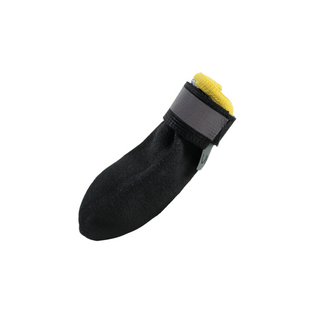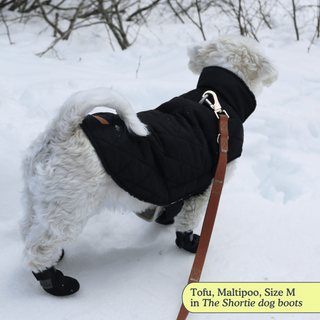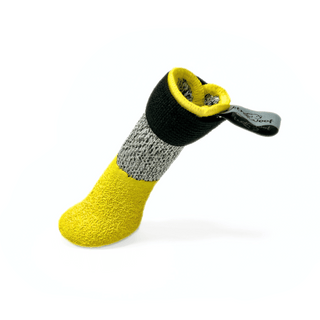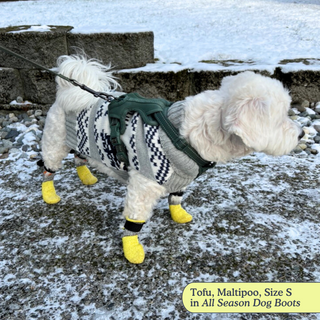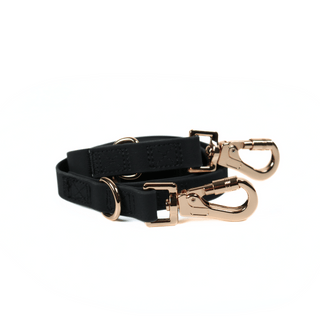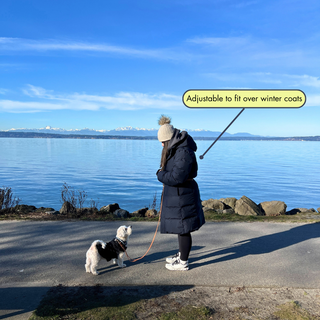As the weather turns colder, many pet owners wonder: When is it too cold to walk my dog?
The answer depends on several factors, including your dog’s breed, size, age, health, and even the type of weather gear you’re using. Here are some tips to understand when it might be too cold to walk your dog and how dog boots can help in the winter to keep your furry friend safe and comfortable!
 "Too cold" will vary depending on your dog's breed, size, and age.
"Too cold" will vary depending on your dog's breed, size, and age.
1. Know Your Dog’s Tolerance for Cold
Your dog’s tolerance for the cold will depend on their breed and physical characteristics. Some dogs like Huskies are naturally equipped to handle lower temperatures, while others like our dogs (Tofu and Noodles) who are maltipoos, need extra protection in the winter.
- Cold-tolerant breeds: Breeds with thick, double-layered coats, like Huskies, Malamutes, and Saint Bernards, are bred for colder climates and can withstand lower temperatures.
- Cold-sensitive breeds: Small dogs, especially those with short or thin coats like Chihuahuas, Greyhounds, or Dachshunds.
- Older dogs or dogs with medical conditions: Older dogs tend to feel the cold more intensely and need more protection. In addition, joint issues, arthritis, or other health conditions can be exacerbated by cold weather so extra protection will be needed in the cold.
2. Temperature Guidelines for When It is Too Cold to Walk Your Dog
While individual tolerance varies, there are some general guidelines you can follow to assess the safety of walking your dog in cold weather. According to NPR, if the temperature is under 30 degrees factoring in wind chill, keep the walks short to potty breaks and avoid taking your dog out for an extended period of time.
- Above 45°F (7°C): Most dogs should be safe and comfortable to go on walks without any special precautions. But keep in mind that in the summer, it can be too hot to walk your dog too.
- 32°F to 45°F (0°C to 7°C): This is generally safe for medium- and large-sized dogs with a thick coat. However, smaller dogs, puppies, and seniors may need some extra insulation, like a vest or sweater.
- 20°F to 32°F (-6°C to 0°C): Dogs with thicker coats will still do fine in this range, but you should start considering cold weather gear, like boots, especially if there’s snow or ice. Short-haired and small dogs may feel uncomfortable, and walks should be kept shorter.
- Below 20°F (-6°C): It's time to be cautious. Even large dogs with thick coats can suffer from frostbite or hypothermia. Limit the length of your walks to short potty breaks, and highly consider putting a coat and a pair of dog boots on your dog.
- Below 0°F (-18°C): At this temperature, most dogs will be at risk, regardless of breed or size. Frostbite can set in within minutes, and paws are especially vulnerable. Only go outdoors for short potty breaks and make sure they are protected from the elements!
3. Protecting Your Dog in Cold Weather
If you need to walk your dog in colder temperatures, there are steps you can take to make sure they stay warm and safe:
 Dog shoes can help protect your dog's paws from the cold and keep them comfortable in cold weather.
Dog shoes can help protect your dog's paws from the cold and keep them comfortable in cold weather.
- Dress appropriately: For cold-sensitive dogs, a well-fitting dog coat or sweater can help maintain body heat. Make sure it's not too tight or restrictive.
- Use paw protection: Dog boots are great for protecting against snow, ice, and salt, all of which can hurt your dog’s paws. If winter is coming, start early by getting your dog used to wearing boots ahead of time through positive reinforcement and familiarization. In addition to dog boots, keep your dog's paws protected and comfortable in the winter with some quick and easy maintenance.
- Shorten walks: In extreme cold, it’s better to keep walks brief. Your dog will still get the exercise they need, but you’ll avoid overexposure to the cold.
- Watch out for salt and ice-melting chemicals: Salt on sidewalks can irritate your dog’s paws, and ice-melting chemicals can be toxic. Wash your dog’s paws after walks to remove any harmful substances.
- Monitor hydration: Cold air can be dehydrating. Make sure your dog has access to fresh water even in winter, especially after walks.
4. Signs Your Dog Is Too Cold
When walking in cold weather, always pay attention to your dog’s behavior. If you notice any of the following signs, it may be too cold for them, and it's best to head home:
- Shivering or trembling: The most obvious sign of cold discomfort.
- Whining or showing signs of anxiety: Your dog may vocalize if they’re too cold or uncomfortable.
- Lifting paws or limping: Cold weather can hurt their paws, especially if there’s ice, salt, or snow.
- Slowing down or seeking warmth: If your dog stops moving and seems to seek warmth or shelter, they’re probably too cold.
- Curling up while standing or huddling close to you: These are other indicators that your dog is trying to conserve heat.
Overall, dog owners should consider the size of their dog, breed, and health before deciding how cold is too cold to take their dog on a walk. So when the temperature drops, be ready to shorten walks and toss on a stylish coat and pair of boots (for both you and your dog)!

